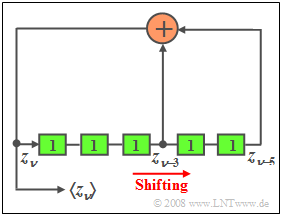Difference between revisions of "Aufgaben:Exercise 2.6: PN Generator of Length 5"
From LNTwww
| Line 4: | Line 4: | ||
[[File:EN_Sto_A_2_6.png|right|frame|PN generator of length $L = 5$]] | [[File:EN_Sto_A_2_6.png|right|frame|PN generator of length $L = 5$]] | ||
| − | In the | + | In the graphic you can see a pseudo-random generator of length $L = 5$, which can be used to generate a binary random sequence $\langle z_{\nu} \rangle$. |
| − | |||
| − | |||
| − | |||
| + | *At the start time, let all memory cells be preallocated with "ones". | ||
| + | *At each clock time, the content of the shift register is shifted one place to the right. | ||
| + | * And the currently generated binary value $z_{\nu}$ $(0$ or $1)$ is entered into the first memory cell. | ||
*Hereby $z_{\nu}$ results from the modulo-2 addition between $z_{\nu-3}$ and $z_{\nu-5}$. | *Hereby $z_{\nu}$ results from the modulo-2 addition between $z_{\nu-3}$ and $z_{\nu-5}$. | ||
| Line 20: | Line 20: | ||
*The exercise belongs to the chapter [[Theory_of_Stochastic_Signals/Generation_of_Discrete_Random_Variables|Generation of Discrete Random Variables]]. | *The exercise belongs to the chapter [[Theory_of_Stochastic_Signals/Generation_of_Discrete_Random_Variables|Generation of Discrete Random Variables]]. | ||
| − | *The topic of this chapter is illustrated with examples in the | + | *The topic of this chapter is illustrated with examples in the (German language) learning video: <br> [[Erläuterung_der_PN–Generatoren_an_einem_Beispiel_(Lernvideo)|"Erläuterung der PN-Generatoren an einem Beispiel"]] $\Rightarrow$ "Explanation of PN generators using an example". |
| Line 38: | Line 38: | ||
| − | {Assume that the generator polynomial $G(D)$ is primitive. <br>Is the initial sequence $〈z_ν \rangle$ an M-sequence? How large is | + | {Assume that the generator polynomial $G(D)$ is primitive. <br>Is the initial sequence $〈z_ν \rangle$ an M-sequence? How large is the period $P$? |
|type="{}"} | |type="{}"} | ||
$P\ = \ $ { 31 } | $P\ = \ $ { 31 } | ||
| − | {What octal identifier $O_{\rm R}$ describes the polynomial | + | {What octal identifier $O_{\rm R}$ describes the polynomial $G_{\rm R}(D)$ reciprocal to $G(D)$? |
|type="{}"} | |type="{}"} | ||
$O_{\rm R} \ = \ $ { 45 } $\ \rm (octal)$ | $O_{\rm R} \ = \ $ { 45 } $\ \rm (octal)$ | ||
Revision as of 15:37, 28 December 2021
In the graphic you can see a pseudo-random generator of length $L = 5$, which can be used to generate a binary random sequence $\langle z_{\nu} \rangle$.
- At the start time, let all memory cells be preallocated with "ones".
- At each clock time, the content of the shift register is shifted one place to the right.
- And the currently generated binary value $z_{\nu}$ $(0$ or $1)$ is entered into the first memory cell.
- Hereby $z_{\nu}$ results from the modulo-2 addition between $z_{\nu-3}$ and $z_{\nu-5}$.
Hints:
- The exercise belongs to the chapter Generation of Discrete Random Variables.
- The topic of this chapter is illustrated with examples in the (German language) learning video:
"Erläuterung der PN-Generatoren an einem Beispiel" $\Rightarrow$ "Explanation of PN generators using an example".
Question
Solution
(1) Correct is the proposed solution 2 ⇒ $G(D) = D^5 + D^3 +1$.
- The generator polynomial $G(D)$ denotes the returns used for modulo-2 addition.
- $D$ is a formal parameter indicating a delay by one clock.
- $D^3$ then indicates a delay of three measures.
(2) It is $g_0 = g_3 = g_5 = 1$.
- All other Rückf coefficients are $0$. It follows that:
- $$(g_{\rm 5}\hspace{0.1cm}g_{\rm 4}\hspace{0.1cm}g_{\rm 3}\hspace{0.1cm}g_{\rm 2}\hspace{0.1cm}g_{\rm 1}\hspace{0.1cm}g_{\rm 0})=\rm (101001)_{bin}\hspace{0.15cm} \underline{=(51)_{oct}}.$$
(3) Since the generator polynomial $G(D)$ is primitive, one obtains an M-sequence.
- Accordingly, the period is maximal:
- $$P_{\rm max} = 2^{L}-1 \hspace{0.15cm}\underline {= 31}.$$
- In the theory part, the table with PN generators of maximum length (M sequences) for degree $5$ lists the configuration $(51)_{\rm oct}$.
(4) The reciprocal polynomial is:
- $$G_{\rm R}(D)=D^{\rm 5}\cdot(D^{\rm -5}+\D^{\rm -3}+ 1)= D^{\rm 5}+D^{\rm 2}+1.$$
- Thus, the octal identifier für this configuration $\rm (100101)_{bin}\hspace{0.15cm} \underline{=(45)_{oct}}.$
(5) The correct solutions are solutions 1, 3, and 4:
- The initial sequence of the reciprocal realization $G_{\rm R}(D)$ of a primitive polynomial $G(D)$ is always also an M-sequence.
- Both sequences are inverses of each other. This means:
- The initial sequence of $(45)_{\rm oct}$ is equal to the sequence of $(51)_{\rm oct}$ when read from right to left and additionally taking into account a phase (cyclic shift).
- A precondition is again that not all memory cells are preallocated with zeros.
- Under this condition, both sequences actually also have the same statistical properties.
